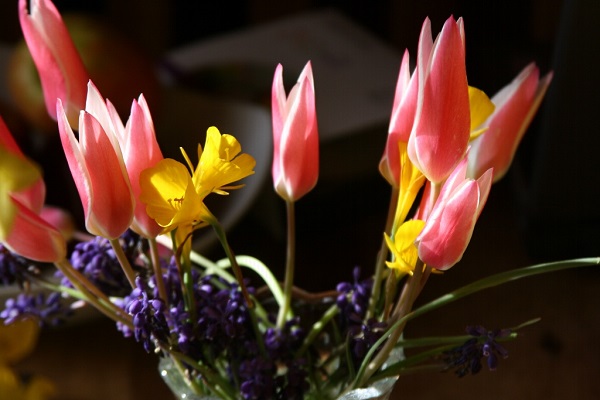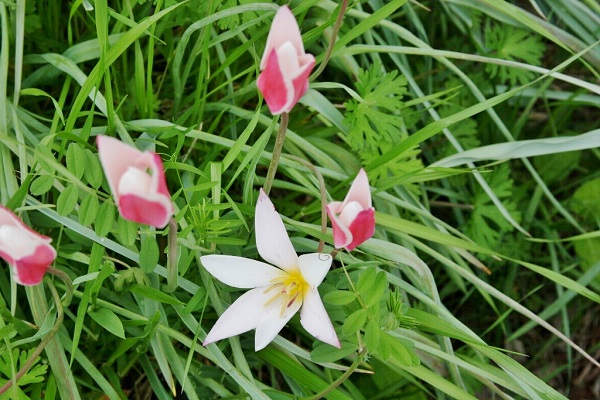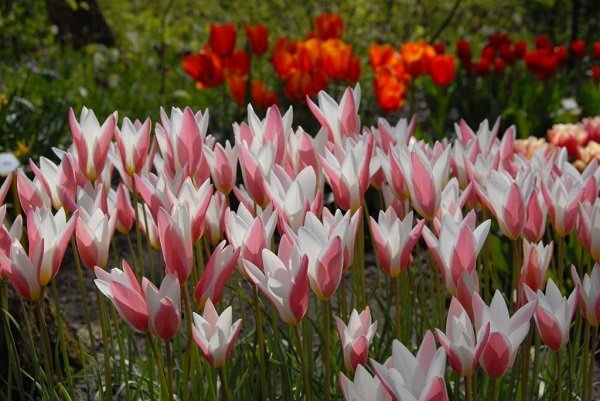

Tulips are recognized the world over for their beauty and bright colors welcoming the spring after a long winter. Species tulips are different from the larger hybrid tulips. Species tulips are shorter with smaller cups and more likely to naturalize and come back for years to come. There is absolutely a place in your garden for the larger hybrid tulips, like the 'Van Eijk', but you need to plan on treating those as annuals and plant them every year. Species tulips can be perennials for you even in the south if you plant them right. The value of tulips in your garden is immeasurable!

History: Most people think of Holland when they think of tulips, and Holland is the largest producer of tulips. But did you know that tulips originally came from the mountains near Afghanistan and Kazakhstan? The tulip then moved toward modern day Turkey where it received its name "tulipan" which means turban. There is some disagreement over the origin of the name. The name is either because the shape of the flower looks like a turban or because sultans would stick a tulip in their turban to show their power and wealth. A very powerful sultan in Turkey would give his guests gifts of tulips. That is how around the late 1500s the tulip made it to Holland. Tulip bulbs were used in place of money and stolen out of gardens. In Holland in the 1630s, a handful of tulip bulbs was worth about $44,000 according to the Old Farmer's Almanac, and a single tulip bulb could buy an entire canalhouse in Amsterdam.

Fun facts: Tulips generally symbolize deep and perfect love. Striped tulips were greatly prized for centuries. Though not known until 1931, striped tulips were originally caused by a virus that was spread by aphids. If you ever wanted to travel to Holland, try to arrange your trip for April or May when the Keukenhof gardens, the largest tulip garden in the world, has more than 7 million tulips in bloom. Tulip bulbs have been eaten during times of famine. During the particularly harsh winter of 1944-45 in the Netherlands during WWII, the government published recipes on how to make tulip soup and tulip flour for bread. Though we don't recommend it, even actress Audrey Hepburn ate tulips with her family during this time in the Netherlands.

What to expect: 'Lady Jane' tulips bloom in late March in the more southern zones and early April farther north. It has a bold impact on the landscape shouting spring. It is one of our most sought after bulbs, and is normally thought of as a species tulip although its exact classification is not with the rest of the species tulips. This fact is of little importance to most home gardeners who appreciate the tulip's return year after year. The reddish pink and white bi-colors are a bright and happy welcome to the garden.

Care and planting: Of course, you can plant them anywhere you want if you want to treat this tulip like an annual large bulb tulip. Plant them. Enjoy them. Then dig them up when they are done performing. If you are going to plant it immediately, the 'Lady Jane' tulip does not need to be stored in the fridge. Just go ahead and plant it. However, if you are going to wait a few days or even a couple of weeks, then keep the bulbs in the fridge. Mix in with herbs and other low growing perennials and winter annuals for a nice contrast of color and texture in the garden. The pink and white of the tulip looks great with March/April blooming daffodils, grape hyacinth, and Spanish bluebells or even other tulips.
However, if you want this lovely lady to naturalize and return every year, then this is the most important part of the 'Lady Jane' tulip. We are going to address each part individually. Consider the conditions of where tulips originally came from...arid and rocky, with warm, dry summers. That is exactly what these bulbs are looking for when you plant them. They are perennials in the wild. We are just trying to provide them with similar sun, soil, and water conditions to make them perennials for us too.

Sunlight: Plant the tulips in full sun. Tulips are heliotropic which means that the blooms bend, move, arc and twist themselves throughout the day in order to be in the best position to receive light. They reach for it. They even do this once you have cut them and bring them into the house. That is why you may want to consider moving the vase around the house throughout the day. Tulips are also photonastic which means that the blooms close up at night and reopen during the day.

Soil: It is the soil situation that is the main factor in determining whether your species tulips become perennials or not. You need well-drained soil for tulips. This is one reason that rocky soil does well with tulips. Soil that dries so much that it cracks in the summer is ideal. We often say to plant you tulips "high and dry". That means think about planting in a raised bed that will completely dry out for the summer. Or consider planting them in a crate where the soil can't cling to the roots and the rain water can be absorbed elsewhere. Not only will a crate help protect tulips from rot and help them to perennialize, but critters like voles can't get to them. Don't use "improved" garden soils or place the bulbs in an irrigated area. Plant the bulbs about 3x the height of the bulb deep. You can plant the bulbs as close together as you want to make it look more natural.

Blooms: The blooms will last well for a couple of weeks, but an unusually hot spring will make the blooms droop. When the tulips are done blooming you may remove the flower stems, but leave the foliage alone to die back on its own. This will allow the bulb to continue to take in nutrients from the sun to last until the next blooming cycle. Once the foliage is completely withered and brown you can mow right over the top of it.

For more information on tulips in the South and what you can do to help them survive, please visit our general Tulip information blog post at Bulb Hunter.
Tulips are recognized the world over for their beauty and bright colors welcoming the spring after a long winter. Species tulips are different from the larger hybrid tulips. Species tulips are shorter with smaller cups and more likely to naturalize and come back for years to come. There is absolutely a place in your garden for the larger hybrid tulips, like the 'Van Eijk', but you need to plan on treating those as annuals and plant them every year. Species tulips can be perennials for you even in the south if you plant them right. The value of tulips in your garden is immeasurable!

History: Most people think of Holland when they think of tulips, and Holland is the largest producer of tulips. But did you know that tulips originally came from the mountains near Afghanistan and Kazakhstan? The tulip then moved toward modern day Turkey where it received its name "tulipan" which means turban. There is some disagreement over the origin of the name. The name is either because the shape of the flower looks like a turban or because sultans would stick a tulip in their turban to show their power and wealth. A very powerful sultan in Turkey would give his guests gifts of tulips. That is how around the late 1500s the tulip made it to Holland. Tulip bulbs were used in place of money and stolen out of gardens. In Holland in the 1630s, a handful of tulip bulbs was worth about $44,000 according to the Old Farmer's Almanac, and a single tulip bulb could buy an entire canalhouse in Amsterdam.

Fun facts: Tulips generally symbolize deep and perfect love. Striped tulips were greatly prized for centuries. Though not known until 1931, striped tulips were originally caused by a virus that was spread by aphids. If you ever wanted to travel to Holland, try to arrange your trip for April or May when the Keukenhof gardens, the largest tulip garden in the world, has more than 7 million tulips in bloom. Tulip bulbs have been eaten during times of famine. During the particularly harsh winter of 1944-45 in the Netherlands during WWII, the government published recipes on how to make tulip soup and tulip flour for bread. Though we don't recommend it, even actress Audrey Hepburn ate tulips with her family during this time in the Netherlands.

What to expect: 'Lady Jane' tulips bloom in late March in the more southern zones and early April farther north. It has a bold impact on the landscape shouting spring. It is one of our most sought after bulbs, and is normally thought of as a species tulip although its exact classification is not with the rest of the species tulips. This fact is of little importance to most home gardeners who appreciate the tulip's return year after year. The reddish pink and white bi-colors are a bright and happy welcome to the garden.

Care and planting: Of course, you can plant them anywhere you want if you want to treat this tulip like an annual large bulb tulip. Plant them. Enjoy them. Then dig them up when they are done performing. If you are going to plant it immediately, the 'Lady Jane' tulip does not need to be stored in the fridge. Just go ahead and plant it. However, if you are going to wait a few days or even a couple of weeks, then keep the bulbs in the fridge. Mix in with herbs and other low growing perennials and winter annuals for a nice contrast of color and texture in the garden. The pink and white of the tulip looks great with March/April blooming daffodils, grape hyacinth, and Spanish bluebells or even other tulips.
However, if you want this lovely lady to naturalize and return every year, then this is the most important part of the 'Lady Jane' tulip. We are going to address each part individually. Consider the conditions of where tulips originally came from...arid and rocky, with warm, dry summers. That is exactly what these bulbs are looking for when you plant them. They are perennials in the wild. We are just trying to provide them with similar sun, soil, and water conditions to make them perennials for us too.

Sunlight: Plant the tulips in full sun. Tulips are heliotropic which means that the blooms bend, move, arc and twist themselves throughout the day in order to be in the best position to receive light. They reach for it. They even do this once you have cut them and bring them into the house. That is why you may want to consider moving the vase around the house throughout the day. Tulips are also photonastic which means that the blooms close up at night and reopen during the day.

Soil: It is the soil situation that is the main factor in determining whether your species tulips become perennials or not. You need well-drained soil for tulips. This is one reason that rocky soil does well with tulips. Soil that dries so much that it cracks in the summer is ideal. We often say to plant you tulips "high and dry". That means think about planting in a raised bed that will completely dry out for the summer. Or consider planting them in a crate where the soil can't cling to the roots and the rain water can be absorbed elsewhere. Not only will a crate help protect tulips from rot and help them to perennialize, but critters like voles can't get to them. Don't use "improved" garden soils or place the bulbs in an irrigated area. Plant the bulbs about 3x the height of the bulb deep. You can plant the bulbs as close together as you want to make it look more natural.

Blooms: The blooms will last well for a couple of weeks, but an unusually hot spring will make the blooms droop. When the tulips are done blooming you may remove the flower stems, but leave the foliage alone to die back on its own. This will allow the bulb to continue to take in nutrients from the sun to last until the next blooming cycle. Once the foliage is completely withered and brown you can mow right over the top of it.

For more information on tulips in the South and what you can do to help them survive, please visit our general Tulip information blog post at Bulb Hunter.